Montana faces a unique challenge with its snakes, especially the rattlesnake. Many people fear these creatures, which often leads to harm on both sides. We aim to replace fear with knowledge, focusing on the state’s snake variety and safety.
We’ll guide you through identifying Montana’s snakes, emphasizing their distinguishing features. Understanding snake behavior and the truth about venomous species is key to safe coexistence. We’ll also share the importance of snakes in the ecosystem, including their role in pest control and medical research.
- Related article: Montana Wildlife Discovery
Are you curious about how to spot Montana rattlesnakes or what to do if you encounter one? We’ve provided practical safety tips for enjoying the outdoors. Whether it’s knowing the right gear to wear or how to react to a snake bite, our advice is to keep you safe without harming these beautiful creatures.
7 Key Takeaways on Montana Snakes
- Most snakes in Montana are not venomous, and snake bites are rare, even in active seasons.
- Snakes play a vital role in the ecosystem by controlling rodent populations.
- Despite its scary reputation, snake venom is used to make important medicines.
- Understanding snake identification and behavior can help us coexist peacefully with them.
- Solid-colored, striped, and patterned snakes in Montana have unique features for identification.
- Prairie Rattlesnakes are the only venomous snakes in Montana and have specific features for identification.
- Practicing snake safety, including keeping a distance and learning what to do in case of a bite, is essential for outdoor enthusiasts in Montana.
General Overview of Snakes in Montana
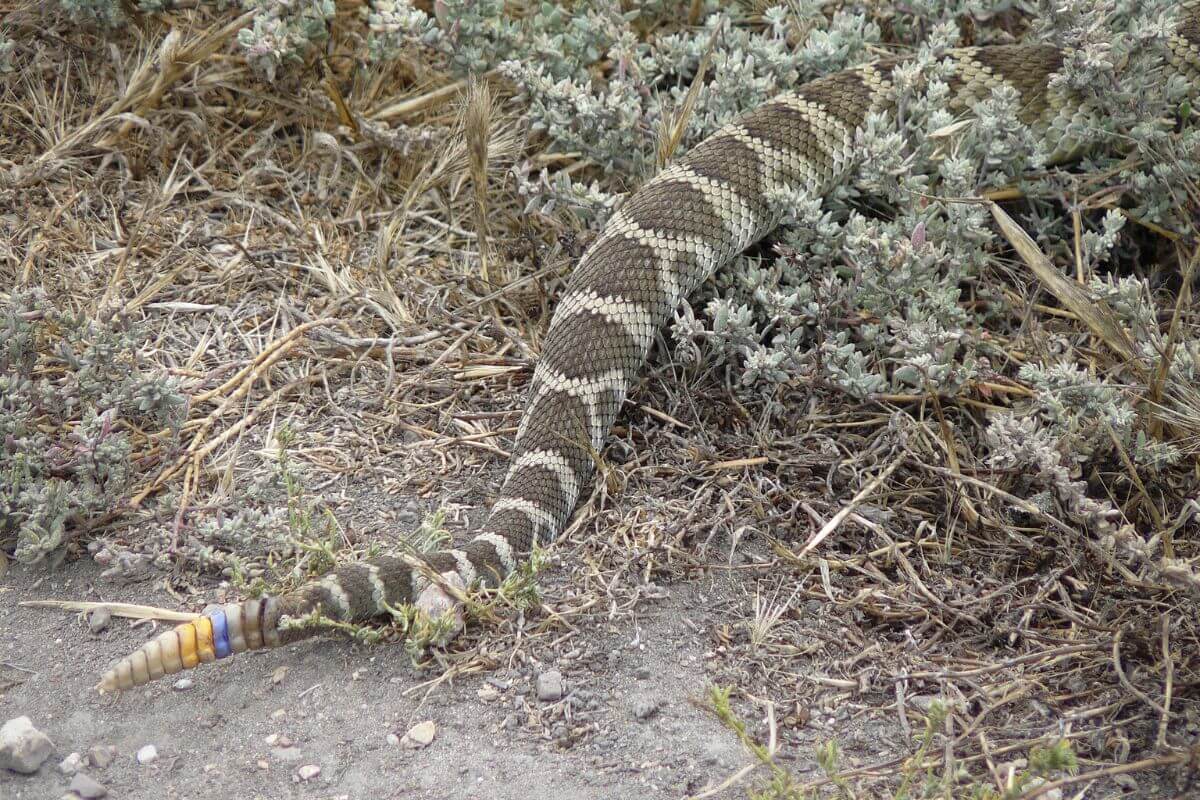
Montana has its share of snake stories like many places. Some people avoid or even kill snakes out of fear. But what if I told you that understanding snakes is the key to living peacefully with them?
In the state, most snakes are easy to spot and not dangerous. Knowing a bit about them can change how we see these slithery creatures.
Out of the 10 snake species in Montana, only one is venomous — the rattlesnake. This means most snakes in the state are not poisonous. Also, snake bites are rare, even during the active snake seasons from spring through fall.
When you see a snake, you might notice it doing certain things to scare you off. Hissing, opening their mouths, or coiling are common defensive moves. Snakes do this to avoid a fight, not to start one. Most of the time, they’ll only come closer if they feel threatened.
It’s a given that you would not want a snake in your home, but they have a few benefits. Snakes are excellent at keeping the rodent population in check. They are like nature’s pest control, slithering around your yard or garden and eating mice and rats.
Some snakes also have venom, which has healing properties. Despite its scary reputation, snake venom makes important medicines for high blood pressure. Research is ongoing to find more ways snake venom can help us, including fighting bacteria that make us sick.
Let’s bust another myth about snakes. These creatures are not slimy. They merely have scales and skin designed to keep them moist.
Snakes are also experts at managing their body temperature. They don’t have ears, eyelids, or legs, but they have ways to stay just the right temperature, whether finding shade on a hot day or basking in the sun when it’s cool.
Next time you spot a snake in the Montana outdoors, remember that it’s just looking for a shady spot or a sunny patch, not a fight.
About Snakes in Montana
Montana is home to various snake species, which play important roles in the state’s ecosystems. Knowing more about them can help residents and visitors stay safe and appreciate Montana’s natural world.
1. Snake Identification in Montana
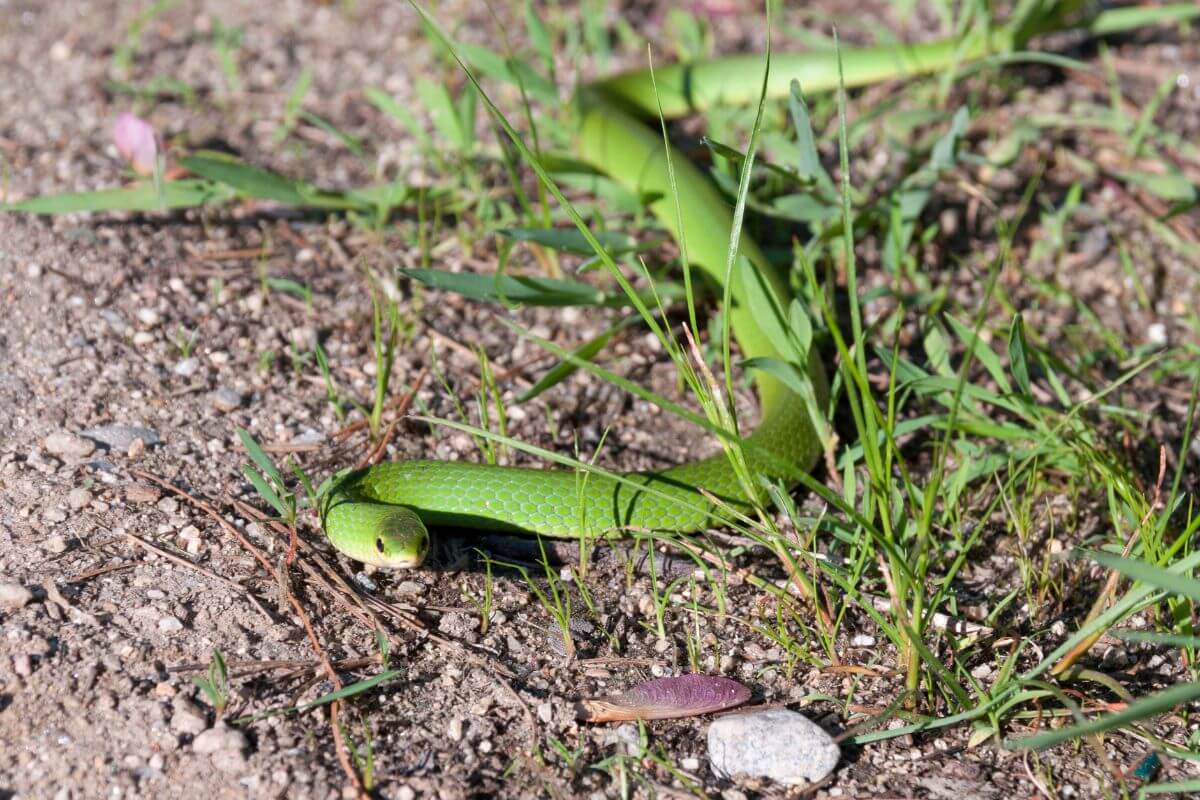
Identifying snakes in Montana sounds scarier than it is. Our native snakes have standout features that make them pretty easy to spot. Focusing on a snake’s patterns and colors can usually tell what kind it is. This method works well because patterns stay the same, unlike colors, which can change slightly.
Let’s break down the different snake species in Montana based on their patterns or colors:
| Color/Pattern | Snake Species |
|---|---|
| Solid Color | North American Racer (adult), Rubber Boa, Smooth Green Snake |
| Longitudinal Stripes | Common Gartersnake, Plains Gartersnake, Terrestrial Gartersnake |
| Banded or Spotted Color | North American Racer (juvenile), Gopher Snake, Plains Hog-nosed Snake, Western Milk Snake, Prairie Rattlesnake |
When figuring out if a snake is venomous, you need to know its kind. Venomous snakes in Montana, like the Prairie Rattlesnake, have specific features that set them apart.
Here’s how to spot the difference between venomous and not venomous snakes to stay safe:
- Head Shape – A rounded head is usually a good sign that the snake is not venomous. Venomous snakes have triangular heads.
- Eyes and Pit – Round pupils are common in non-venomous snakes, while venomous snakes have elliptical (cat-like) pupils.
- Behavior – Many snakes shake their tails as a warning, but rattlesnakes do this differently. They hold their tails up to make a rattling sound while non-venomous snakes shake their tails from side to side.
Fear can make us see things that aren’t there. If you’re afraid of snakes, you might think you see a venomous one when it’s harmless. That’s why learning about snake features and behavior is so important.
2. Solid-Colored Snakes in Montana
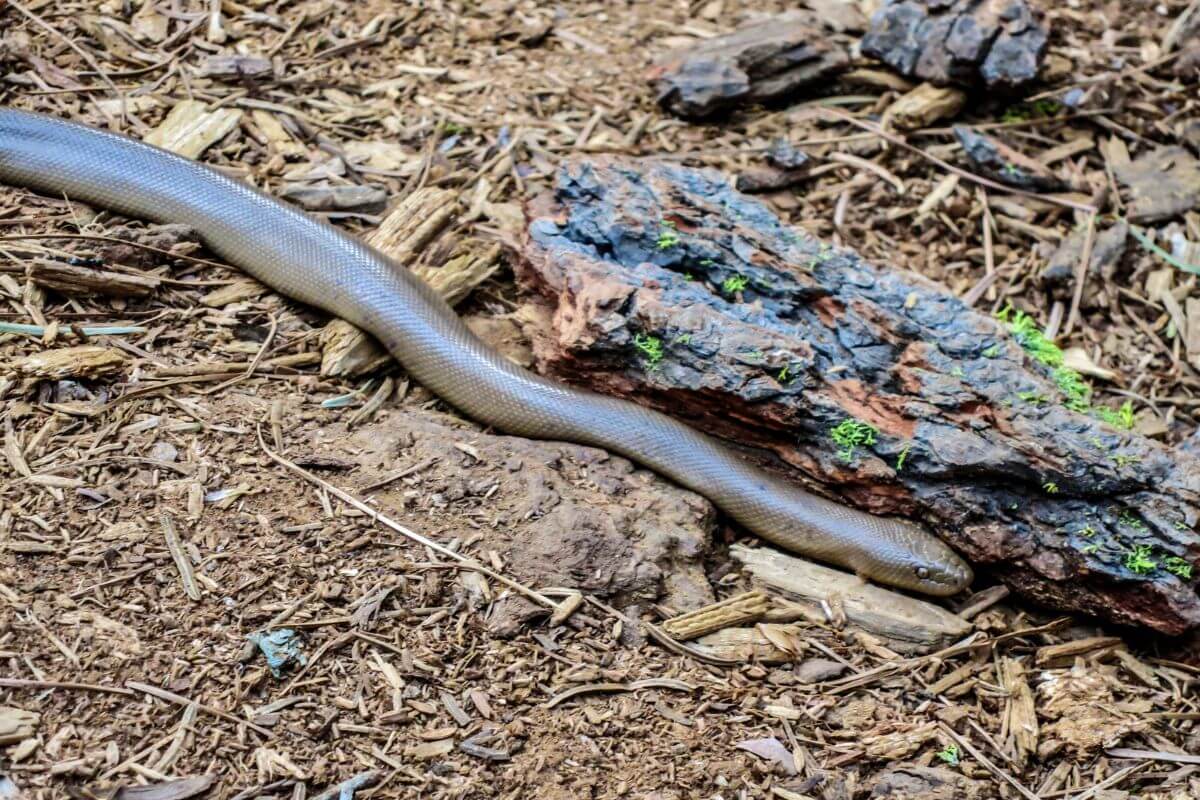
Montana is home to various solid-colored snakes, a term herpetologists (those who study snakes) use to describe snakes with a dominant single color on either their back or belly. Though predominantly of one color, these snakes still exhibit some color variation.
Let’s meet some of the solid-colored snakes in Montana:
| Common Name | North American Racer | Northern Rubber Boa | Smooth Greensnake |
|---|---|---|---|
| Scientific Name | Coluber constrictor | Charina bottae | Opheodrys vernalis |
| Identifying Trait | The North American Racer snake has large, round black eyes and an olive-green to gray body. The juvenile has a yellowish belly and brown blotches. | The Northern Rubber Boa snakes are uniformly thick and vary in color from brown to dark brown to olive. | Smooth Greensnake has a uniformly colored back, cream to light yellow belly, and bright red tongue with a black tip. |
| Habitat | The North American Racer snake prefers grasslands and sagebrush areas. | Northern Rubber Boa snakes prefer wooded areas in the western third of Montana, up to 7,000 feet elevation. | Smooth Greensnakes prefer the upper northeast corner of Montana. |
| Behavior | North American Racers are active during the day and are visual hunters. | Northern Rubber Boas are nocturnal hunters. | Smooth Greensnakes are docile and secrete fluid when handled. |
Armed with the knowledge of their colors and characteristics, encountering these snakes can turn fear into fascination. Remember, in most cases, they are more afraid of you than you are of them.
3. Striped Snakes in Montana
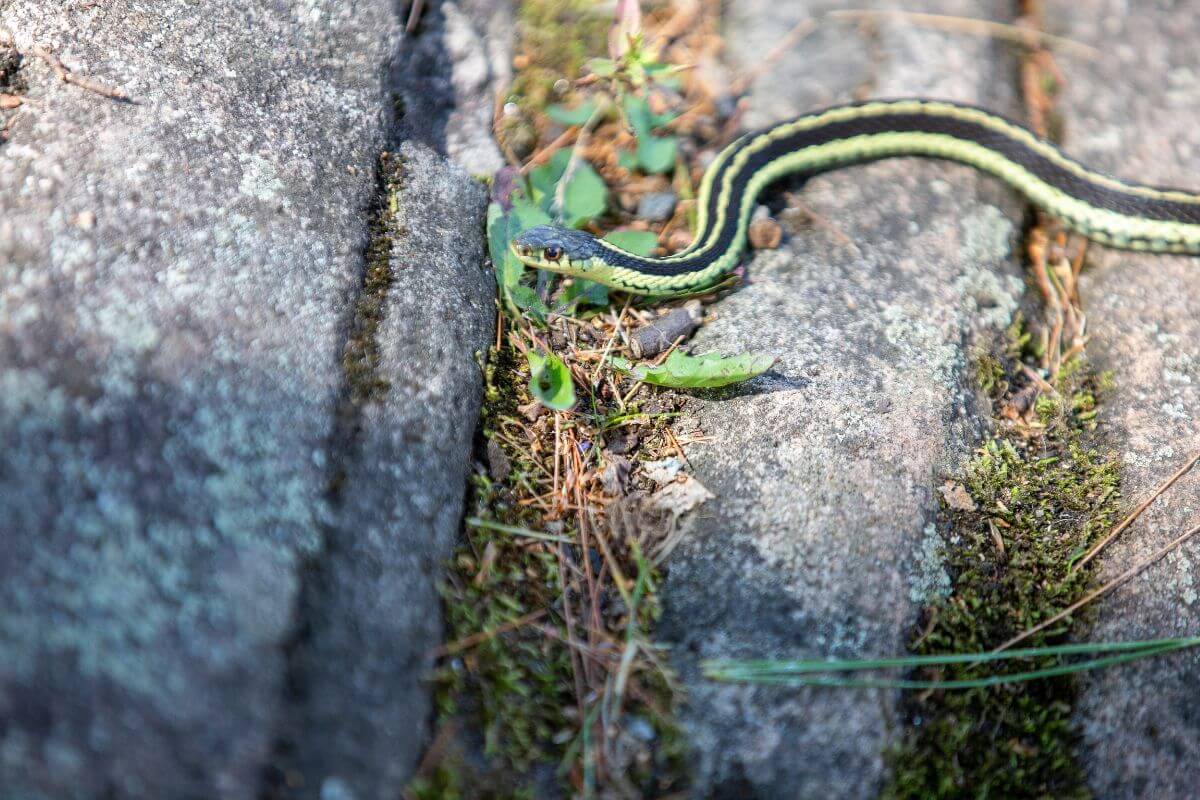
Garter snakes are the friendly faces of Montana’s snake population. They get their name from the “garters” or stripes that run down their bodies. These stripes help us pick them out from the rest of the slithery crowd. In most cases, the stripes are a sunny yellow. Now and then, you might spot a garter snake with stripes that rock a blue or red vibe.
Montana has three main types of garter snakes: the Common Gartersnake, Plains Gartersnake, and Terrestrial Gartersnake. These snakes are not picky about their habitats and can be found throughout the entire state, even at elevations as high as 9,000 feet.
Garter snakes often live in places with high moisture. You’ll catch them in areas where the air is damp and full of tasty treats like bugs and amphibians. This preference for wet spots explains why they’re not big fans of the dry summer heat.
One cool thing about garter snakes is how they handle (or rather avoid) meeting us humans. They’re relatively calm and would rather not engage in a fight. If you do happen to pick one up, they might release a little fluid.
When you’re out and about in Montana and see a snake with stripes, it’s probably just a garter snake. Say hi if you want, but they’re pretty good at keeping out of our way.
4. Patterned Snakes in Montana
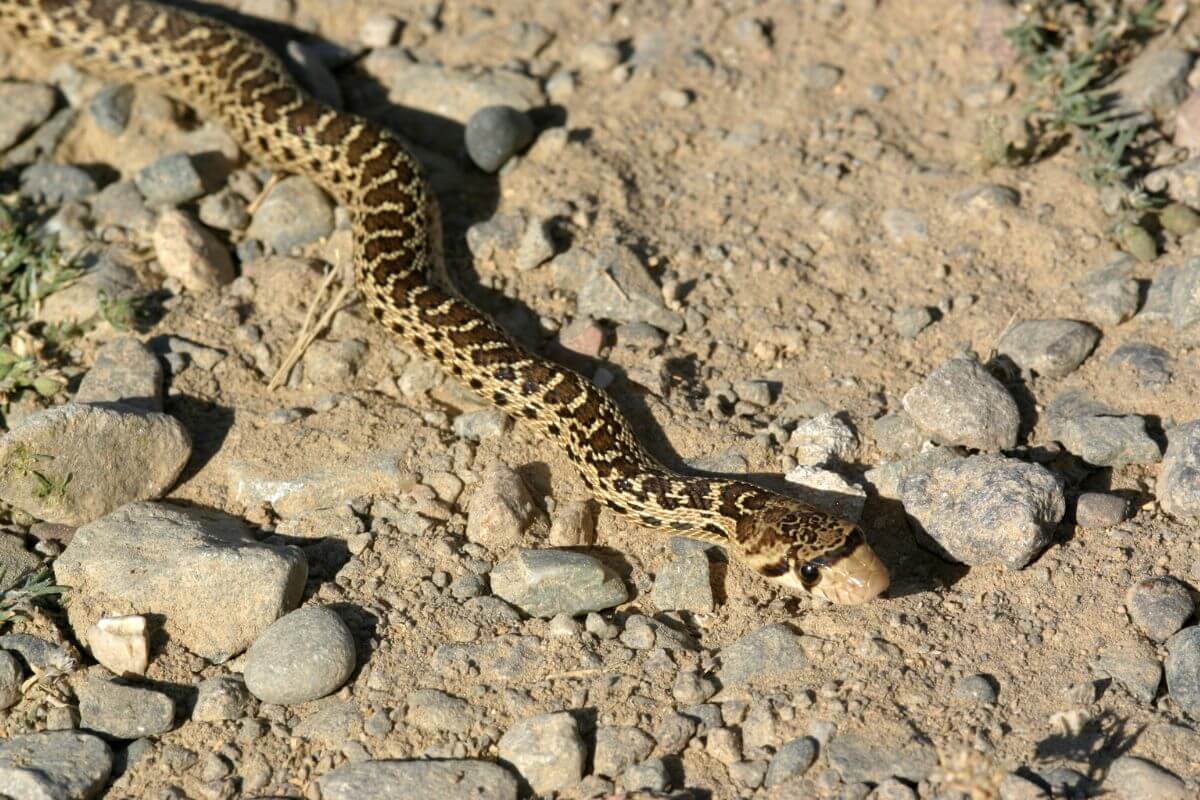
Montana is home to various patterned snakes that are both fascinating and, for some, a source of fear. Knowing more about these snakes and their unique patterns can help us appreciate the diversity of Montana’s wildlife and ease our worries.
Let’s take a closer look at some of the patterned snakes you might encounter in Montana:
- Gophersnake (Pituophis catenifer) – Also known as the Bullsnake, Gopher Snakes boast a blotched pattern that runs the length of their body, which could either be black or brown blotches. Gopher snakes are the longest snakes in Montana, averaging between 3 and 5 feet and sometimes reaching 7 feet. They are mainly found in the central and eastern parts of the state.
- Plains Hog-Nosed Snake (Heterodon nasicus) – The Plains Hog-Nosed Snake is easily recognizable by its upturned snout, which it uses to dig in soft soil. It is covered with colored blotches ranging from tan to gray. It inhabits the plains of the eastern two-thirds of Montana at elevations below 4,000 feet.
- Western Milksnake (Lampropeltis gentilis) – The Western Milksnake sports an orange/red, black, and white pattern. It is found in the eastern two-thirds of Montana at lower elevations. These snakes have interesting defense mechanisms, including coiling, tail rattling, and biting. They are also known to defecate if handled.
Encountering these snakes, with their unique patterns, can be a memorable part of exploring Montana’s outdoors.
Prairie Rattlesnake: The Only Venomous Montana Snake
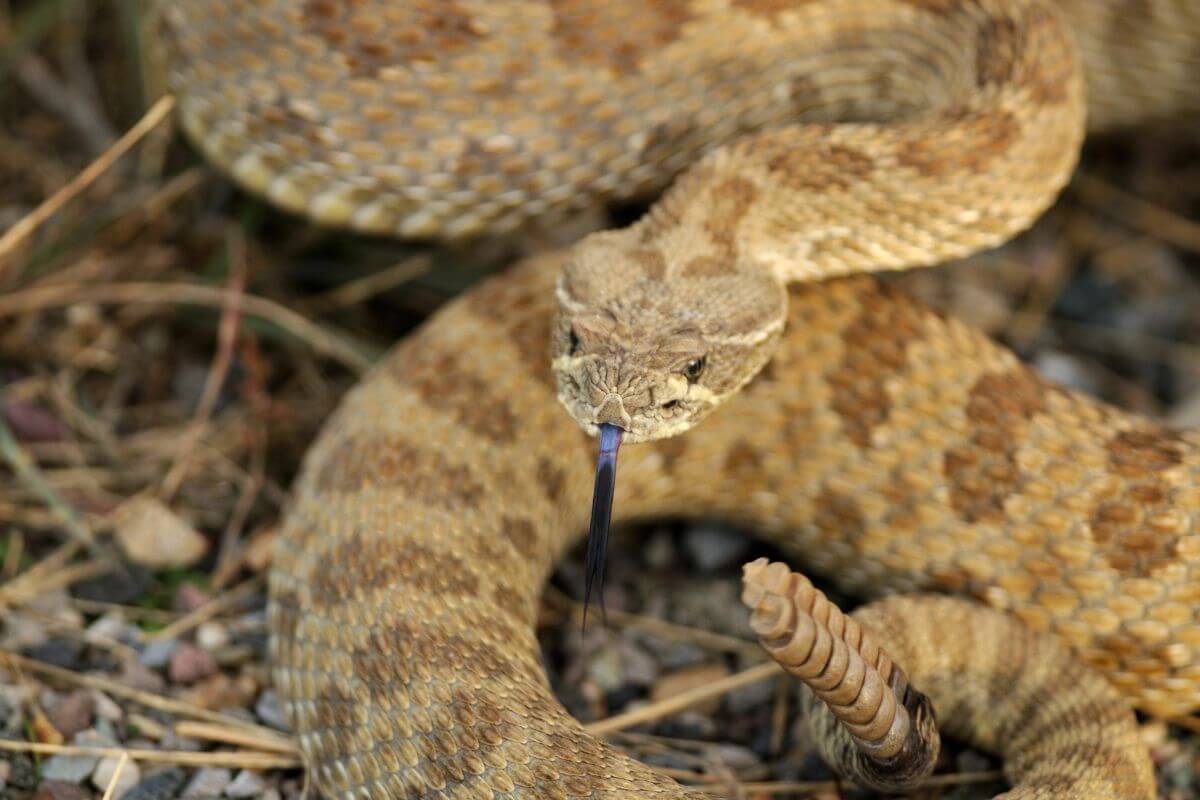
The Prairie Rattlesnake, also known as the Western Rattlesnake, stands out in Montana as the only venomous snake among the state’s ten snake species. Knowing about this snake is crucial for anyone spending time outdoors in Montana. Here’s why:
- Identification – Prairie Rattlesnakes are typically pale green to brown with black to dark blotches that turn into rings at the tail. However, using color and pattern alone for identification is risky because these features can vary. What sets them apart are their triangular heads and bony, rattling tails.
- Size and Distribution – Adult Prairie Rattlesnakes in Montana grow between 24 and 45 inches, with females being larger. They are found throughout the state at elevations below 6,400 feet, especially in arid areas. Common spots include along the Madison River, the northern parts of Gallatin Valley, and Paradise Valley from Livingston to Yellowstone National Park.
- Mating and Diet – Mating happens in the summer, leading to female Prairie Rattlesnakes giving birth from late August to early October. Their diet mainly consists of rodents like prairie dogs and rabbits, with the young ones occasionally eating smaller reptiles and amphibians.
- Defensive Behavior – When encountered, Prairie Rattlesnakes prefer to stay still and move away. But they will coil, rattle, and strike if they feel cornered or threatened. Handling any snake, especially a rattlesnake, is not a good idea and can lead to dangerous situations.
The history of Prairie Rattlesnakes in Montana shows that they are a natural part of the ecosystem. The key is to learn to live with them peacefully and understand their role in nature.
Montana Snake Safety Tips
Being prepared is important before you set out on your Montana adventure. Snake safety is a crucial part of enjoying the outdoors here. Let’s explore some essential tips to help you stay safe and confident while exploring Montana’s beautiful landscapes.
1. Outdoor Snake Safety Tips
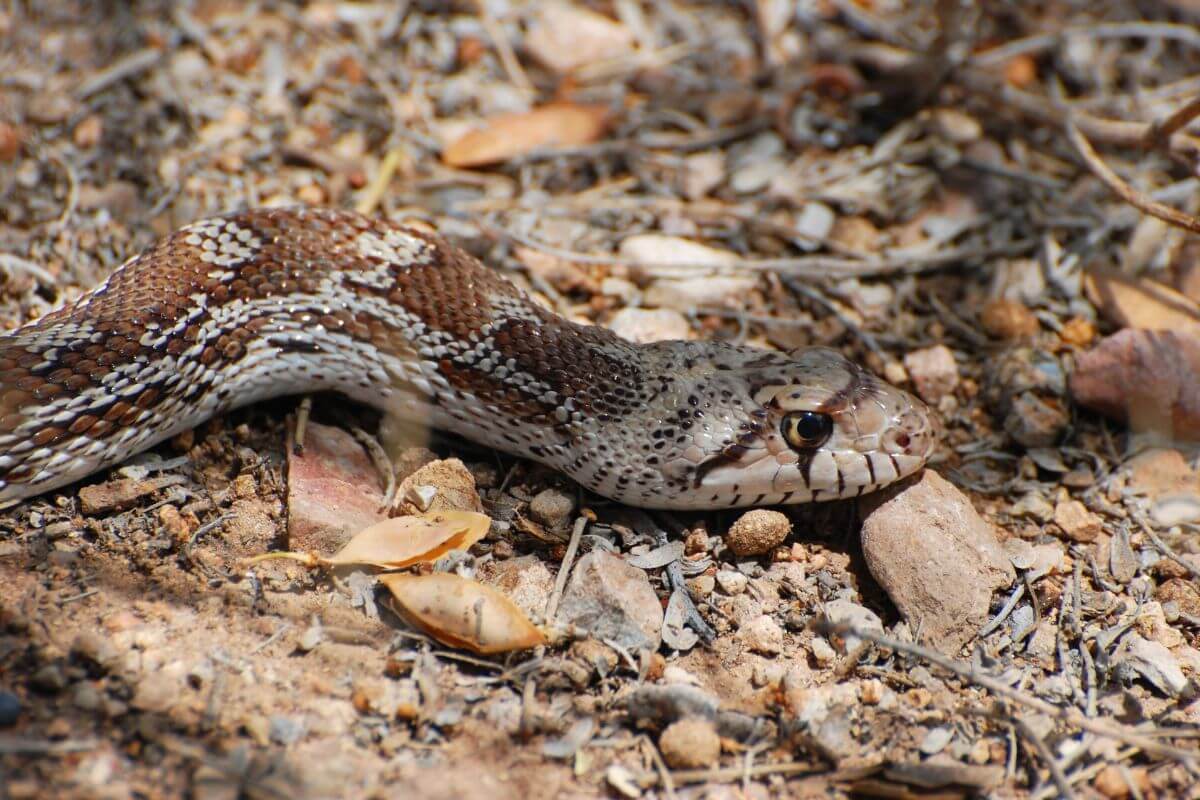
Spring through fall in Montana is a dream for anyone who loves the outdoors. These are the seasons when nature shows off its best. Snakes, including rattlesnakes, are more active during this time because they’ve come out of winter hibernation, so you’re more likely to encounter them.
Here are some simple and important tips for staying safe around snakes when you’re out and about in Montana:
- Be Alert and Watchful – Especially from April to September when snakes and people are most active.
- Stick to the Trails – Sticking to the trail is important. It’s safer for you and the snakes.
- Watch Where You Step – Before putting your foot down, look. The same goes for your hands — watch before you put it anywhere.
- Wear the Right Gear – Closed shoes or boots and long pants help protect you from snake bites.
- Keep Your Distance – If you see a snake, give it space. Walk around it, making sure to stay 15-20 feet away.
- Teach Kids to Stay Back – Ensure they know to avoid snakes and tell an adult if they see one.
- Don’t Try to Kill Snakes – Leaving them alone is safer for everyone, and trying to kill one can result in bites.
- Be Careful With Dead Snakes – Dead snakes can still bite, so it’s best not to touch them.
- Use a Stick to Scare Snakes Away – When hiking, a stick can help you move snakes out of your path without getting too close.
Just because snakes are around doesn’t mean you have to be scared to go outside. Snakes play a big role in our ecosystem. With some know-how and caution, you can explore Montana’s stunning landscapes without worry. You’ll keep yourself and the snakes safe.
2. Snake Bite Tips
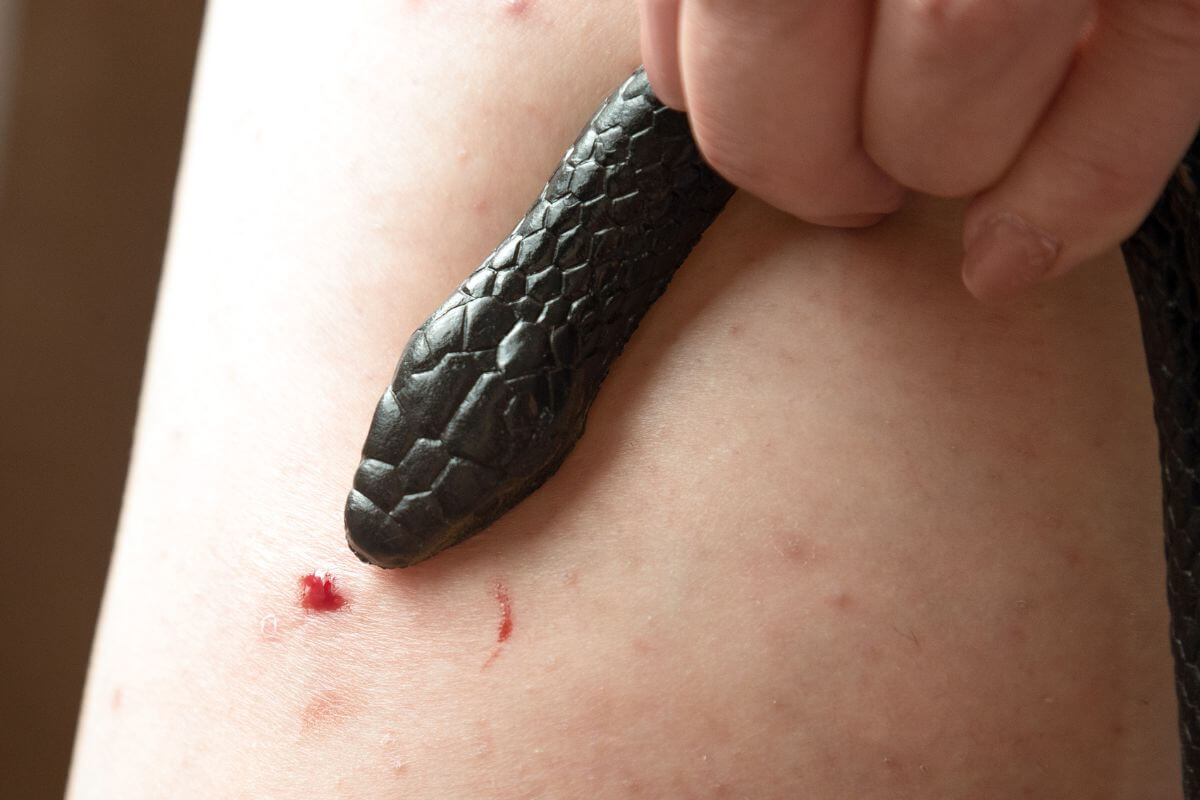
Quick and calm action can make all the difference when facing a snake bite. Though getting bitten by a snake is not common, it’s crucial to be ready. Most snake bites happen on the hand, calf, or ankle, and they hurt. Sometimes, they lead to serious symptoms like trouble breathing, swelling, and nausea.
If bitten by a snake, you should:
- Stay Calm and Still – This helps slow the venom’s spread.
- Move Away From the Snake – Don’t let it bite you again. If you can, take a picture of the snake from a safe distance.
- Call 911 Immediately – Getting help quickly is key.
- Take Off Anything Tight – This includes jewelry and watches to prepare for swelling.
- Keep the Bitten Area Still – You can use a splint or sling to do this gently.
If bitten by a snake, you should not:
- Try to Catch or Kill the Snake – Leave that to the experts to identify the snake and decide on the best treatment.
- Cut the Wound or Try to Suck Out the Venom – These don’t help and can make things worse.
- Use a Tourniquet or Ice Pack – These can cause more harm.
- Let the Person Drink Alcohol – It interacts badly with the snake’s venom.
Remember, the chances of a snake bite are low, even though many snakes live in Montana. Knowing what to do makes you safer.
3. Snake Control Tips
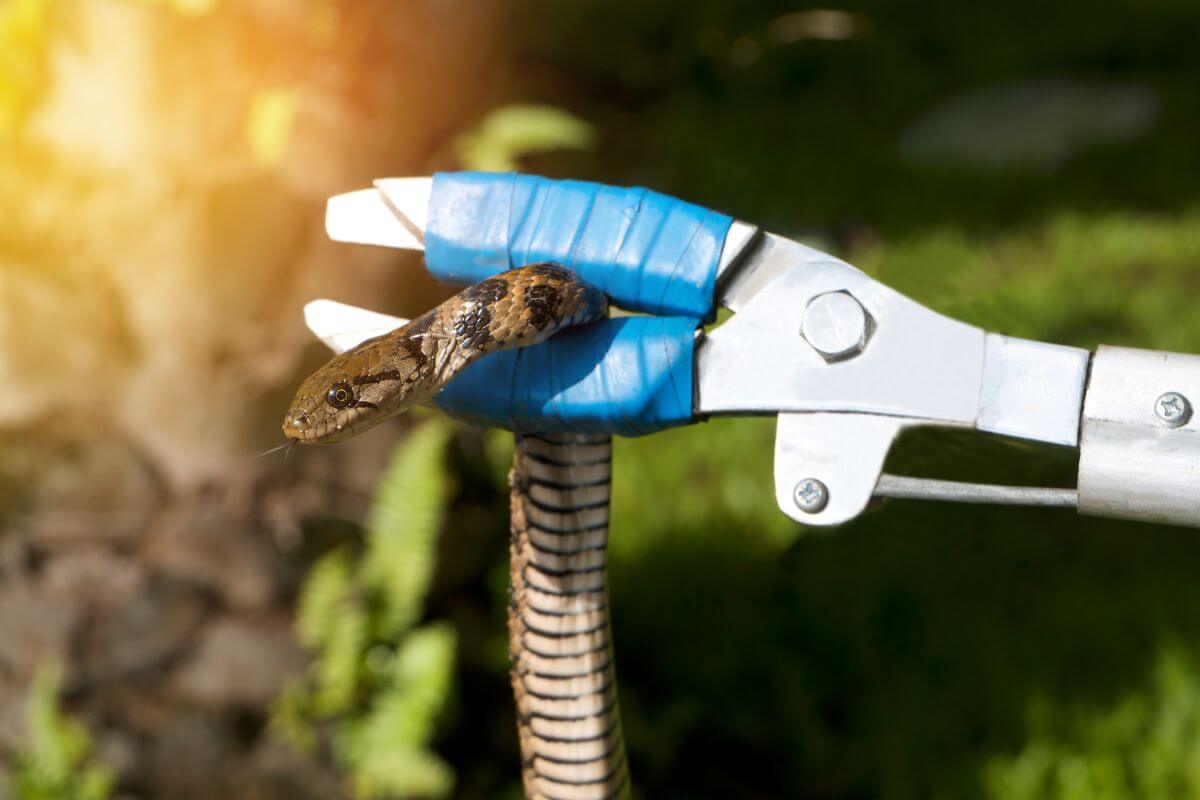
When it comes to dealing with snakes around your home, it’s important to separate fact from fiction. You might have heard many things about deterring snakes using mothballs or certain chemicals that aren’t true.
These home remedies, such as lime, sulfur, and others, have not been proven to work. The same goes for fumigants and poisons — none of them are made for snake control.
The best way to keep snakes away is to make your place less inviting for them. This means changing their living conditions so they’re more likely to look for a new home. Here are some key steps to make your home and surroundings less snake-friendly:
- Clear out Hiding Spots – Avoid places where snakes like to hang out. This means cleaning up cool, dark, and damp areas, like cluttered basements or piles of old stuff.
- Keep Your Yard Tidy – Snakes prefer areas with lots of cover, like tall grass and weeds. By keeping your lawn short and free of clutter, you make it less appealing to them.
- Trim Trees and Shrubs – Ensuring there’s space under trees and shrubs makes it harder for snakes to move around unnoticed.
- Store Firewood Properly – Keep firewood away from your home and above the ground. This helps because piles of wood are perfect hiding spots for snakes.
- Manage Your Garbage – Use sealed trash cans and keep them away from the house. This helps prevent rodents, which are a snake’s favorite food, from getting too close.
Now, it’s not all bad to have some snakes around. Certain non-venomous snakes help by eating pests. For example, some snakes are great at keeping the rodent population down. So, a balanced approach to snake control is key.
4. Venomous Snake Safety Tips
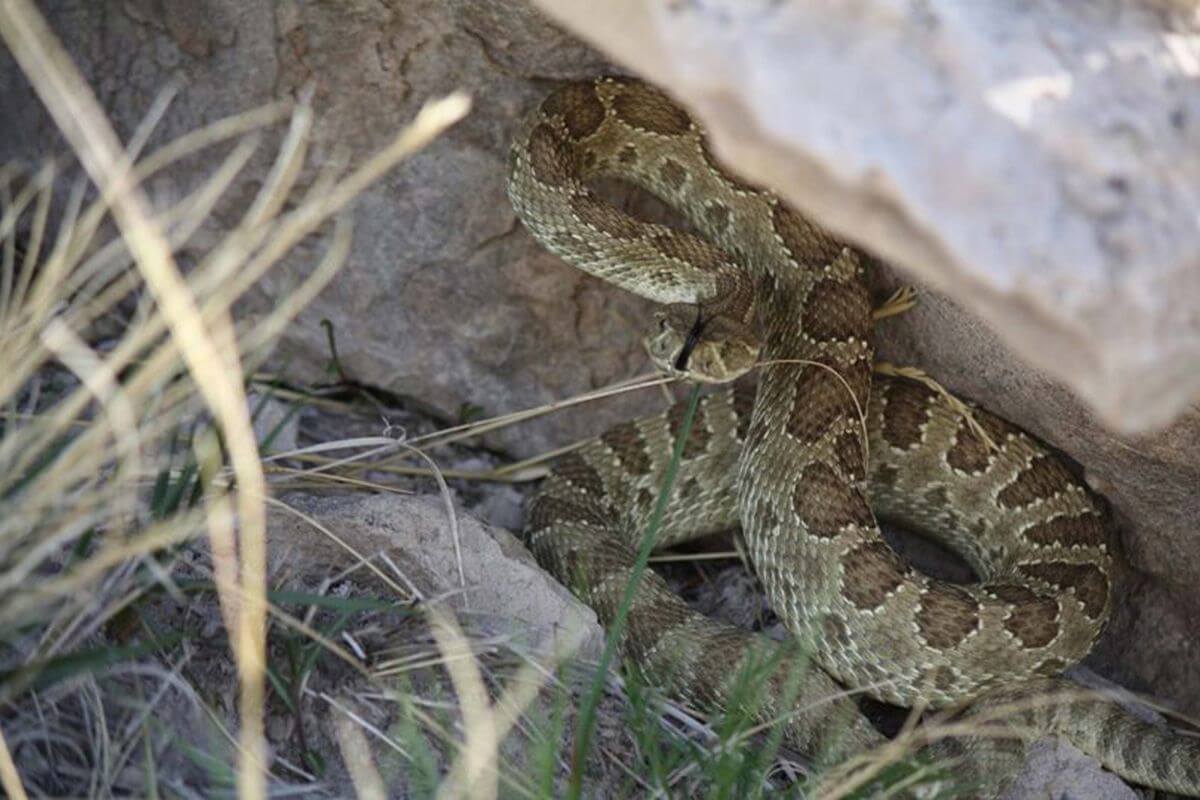
When you’re in Montana, especially in open, dry areas or near water, you might encounter Prairie Rattlesnakes. They’re pretty common in spots with lots of sun, on rocky slopes, and even around houses. But here’s the thing: the chances of a rattlesnake biting you are low, way lower than the chances of getting hurt doing other outdoor stuff.
The venom from Prairie Rattlesnakes can be dangerous, but let’s look at the facts. In Montana, it’s rare for someone to die from a rattlesnake bite. In the last 10 years, the Montana Poison Center hasn’t heard of any deaths from rattlesnakes.
According to Shireen Banerji from the Rocky Mountain Poison and Drug Center, about 16 people get bitten yearly in Montana. Most of the time, these bites don’t cause big problems.
Here are some tips for when you’re around a venomous rattlesnake in Montana:
- Listen for the Rattle – A rattlesnake’s noise when shaking its tail is a clear warning that it’s there.
- Stay Alert – It’s important to be aware of your surroundings. If wearing headphones, consider turning off your music so you can hear the rattle.
- Avoid Tall Grass – Rattlesnakes like places where they can hide easily, like in long grass.
- Watch Your Step – They can be anywhere in the wild and on paths and roads.
If you do see a rattlesnake on the trail:
- Locate the Snake – Once you hear the rattle, try to see where the snake is.
- Back Off Slowly – Rattlesnakes usually don’t want to fight, so if you give them space, they’ll probably just go on their way.
By staying aware of your surroundings and following simple precautions, you can safely enjoy exploring Montana’s beautiful landscapes.
Montana Rattlesnakes Final Thoughts
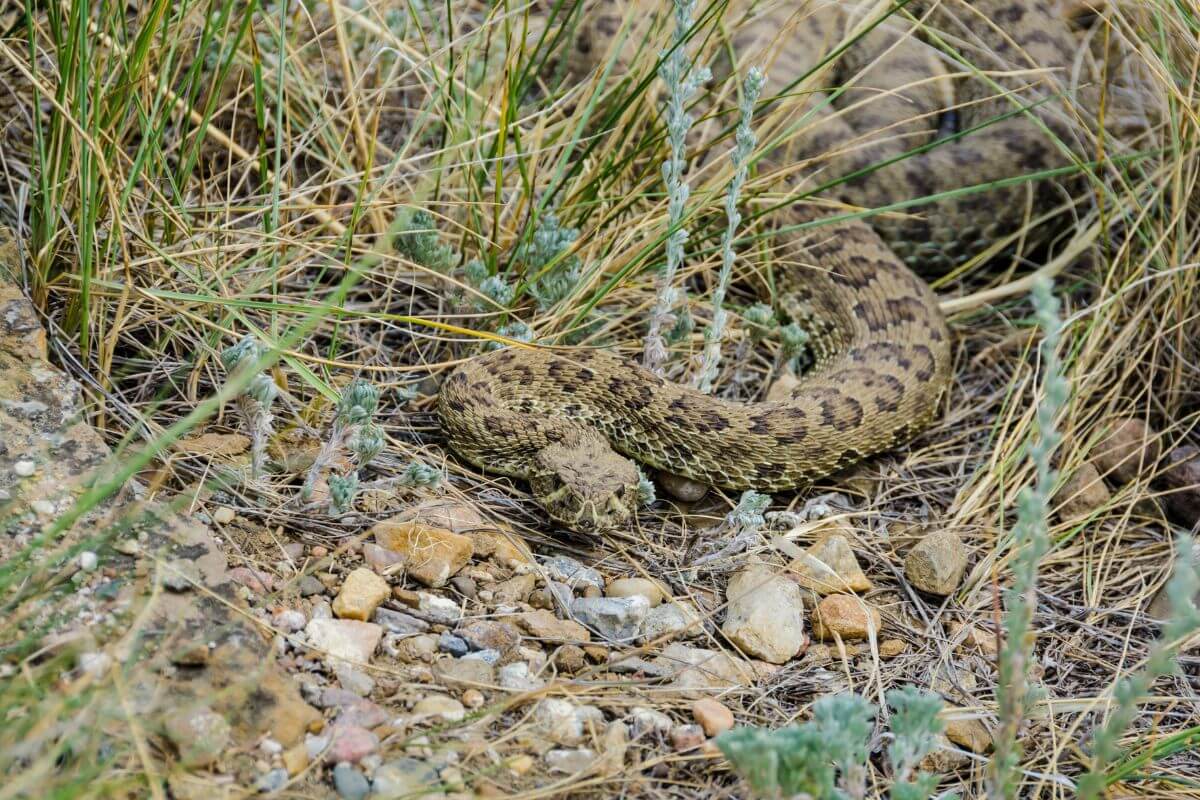
Montana’s snake species, especially the infamous rattlesnake, might spark fear in many. However, armed with the right knowledge, we can transform that fear into respect and understanding.
Most snakes in Montana are non-venomous, and snake bites are rare, even in their active seasons. Embracing these slithery residents as essential to the ecosystem opens the door to peaceful coexistence.
Solid-colored, striped, and patterned snakes each have unique characteristics, aiding in identifying and highlighting the diversity of Montana’s wildlife. Learning to spot the differences not only ensures safety but also offers a glimpse into the fascinating world of these creatures.
The Prairie Rattlesnake or the Western Rattlesnake, the state’s only venomous snake, stands out with its specific features, emphasizing the importance of snake safety education. Remember, keeping a safe distance and knowing what to do in case of a bite are paramount for all outdoor enthusiasts.
Montana Rattlesnakes FAQs
1. Where in Montana Are There Rattlesnakes?
Rattlesnakes can be found in various regions of Montana, particularly in the eastern and southeastern parts of the state, where the climate and habitat are more suitable for them. They inhabit diverse habitats such as grasslands, prairies, shrublands, and rocky areas.
2. What Is the Deadliest Snake in Montana?
The Prairie Rattlesnake (Crotalus viridis) is considered the deadliest snake in Montana. While its venom is potent and can cause serious harm if bitten, fatalities from rattlesnake bites in the state are rare due to prompt medical treatment.
3. Are Snakes a Problem in Montana?
Snakes, including rattlesnakes, are part of Montana’s natural ecosystem and play important roles in controlling rodent populations and maintaining ecological balance. While encounters with snakes are common, they are generally not considered a significant problem for most residents.
4. Are Rattlesnakes Protected in Montana?
Rattlesnakes are not specifically protected by state law in Montana. However, they are subject to general wildlife protection regulations for all native species. They are considered an important component of the state’s natural ecosystem and are managed accordingly.
5. How Common Are Rattlesnakes in Montana?
Rattlesnakes are relatively common in certain regions of Montana, particularly in the eastern and southeastern parts of the state. While encounters with rattlesnakes are common in these areas, they are generally not encountered as frequently as in some other states with warmer climates.
Immerse yourself in the vibrant Montana scene through these reads:

